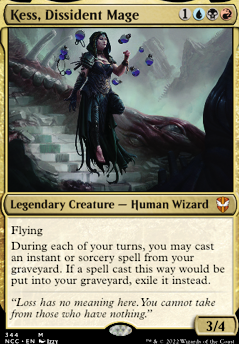In this next section we will be looking at the strengths and weakness of this archetype. If you've never played a Consultation deck before, then strap yourself in because you're in for a ride.
Strengths of the Archetype:
-
The deck itself is resilient and effective because the deck itself is able to evade many of the proactive hate pieces in the format. Stax pieces such as Cursed Totem, Linvala Keeper of Silence, Aven Mindcensor, Stranglehold, Grafdigger’s Cage and Leyline/R.I.P., typically see play in most cEDH stax decks, and those cards don’t per se affect the deck all that hard, just by the nature of how the deck is built, as well as how the deck plays out. Now, before you say, “But we’re playing Kess! We need our Graveyard!”, let’s stop you right there. Sure, having access to the graveyard helps Kess, but the deck can operate without a functioning graveyard, as it really only needs its game winning combo in hand in order to get the job done.
-
Typically this kind of deck runs between 4 and 6 creatures total, not counting the general, and those creatures are: Snapcaster Mage, JVP, Bob (Dark Confidant), Notion Thief, Lab Man, and now, Dockside Extortionist. These creatures naturally evade most on board stax hate pieces, such as the ones listed previously. It also makes the deck resistant to Tabernacle effects, which can cripple some decks, should you choose to run it.
Furthermore, of the six creatures mentioned, at most, the deck really only needs to run 2 of those creatures, specifically Laboratory Maniac and Notion Thief, in order to function, each of which evade most creature oriented stax pieces, as their abilities are static in nature.
-
The nature of how this deck wins is not only compact, but modular in nature. Typically this deck wins through the A + B Combo of “Lab Man” + “Consultation” effect, and in this case, we have two different Consultation effects (DC/TP) and two Lab Man effects (Lab Man and JWM). If worse comes to worse, the deck can also run Praetor’s Grasp to steal another opponent’s Lab Man/JWM, just in case our own Lab Men get compromised.
To be fair to other stax decks, cards such as Null Rod, Stony Silence, Collector Ouphe, and some other stax pieces (such as ones that hate on non-basic lands) can be problematic, as the deck relies on fast mana from artifacts and non-basics, but the archetype benefits from a comprehensive suite of interaction that would, in most cases, allow this deck to interact with those problematic cards while they’re on the stack, or remove them if necessary, once they’ve resolved.
Weaknesses of the Archetype.
-
We do not have an infinite mana outlet in the command zone, and we are not running white for Angel’s Grace, which means we can't win directly off any of the format staple A+B 2 card combos, such as ANAG (Ad Naus/Angel’s Grace) or Dramatic-Scepter. That means we’re ultimately going to be grinding our way to victory, and games are going to be long.
-
Likewise, our opponents are going to eventually realize that we are an Ad Nauseam variant deck. And that means that we must be willing to expect that our opponents are going to try to pressure our life totals early and often with creature beats. This is important, not only because we’re an Ad Naus deck, but because our most effective creature wraths are going to leverage our life total as a resource (Toxic Deluge and Rolling Earthquake, especially).
-
A Chance of Failure. There’s a small chance of failure inherent within the usage of DC/TP, which will be detailed in the next two paragraphs.
A. In the case of Demonic Consultation, there is a small chance of failure; if the card you’re looking for is in the top 6 cards of your library, your entire library will end up being exiled, and you’ll end up losing the game due to decking yourself. Occasionally, one of your deck’s two main wincons (or another card that could be useful), might also end up getting exiled in the process of you looking for a specific card with DC, and that’s the price you’ll have to be willing to pay in order to play this card.
In a more real world sense, on average, you can expect to have roughly 70 to 80 cards left in your library before you attempt to combo off with your A + B combo. This means, based on hypergeometric distribution math, you can expect a failure rate of anywhere between 7.5% and 8.5% when using D.C., at this point. This is important to point out because, as the size of your deck shrinks, the average likelihood to brick on D.C. will go up incrementally; at 60 cards left in the library, for example, D.C.’s chance of failure increases to 10%.
If and When you happen to flip into the card that you’re looking for in the top 6 cards, you will feel stupid and your opponents will laugh at you. It’ll feel about as bad as bricking on an Ad Nauseam.
B. On the other hand, with Tainted Pact, the building of the deck’s manabase requires a true singleton manabase, meaning that we’ll only be able to play one of each type of basic land, to include snow-covered basics. Naturally, this makes us potentially weak to cards that hate on non-basic lands, such as Blood Moon, Magus of the Moon, Contamination, Ruination, and most especially, Back to Basics. You cannot let Back To Basics either resolve, or stay on the board. It must be dealt with on the stack or bounced immediately or else you will get crippled in the long run. Expect mono blue decks like TCV Stax and Urza Powered Scepter to run this card.
- Finally, there are people out there who do run, and will run, cards that have Split Second mechanic, such as Wipe Away and Extirpate. A well-timed Wipe Away when trying to deck yourself will kill you, and a well timed Extirpate will hinder your reanimation plans if Lab Man is in your graveyard. Expect these tactics, and prepare in advance.



